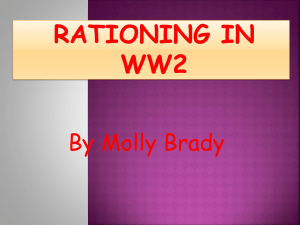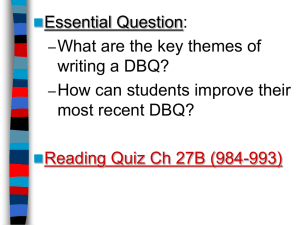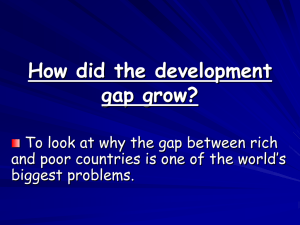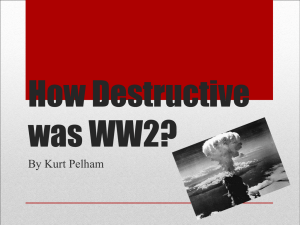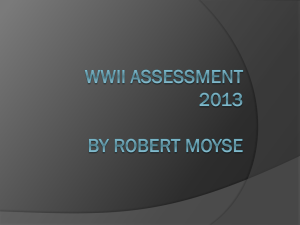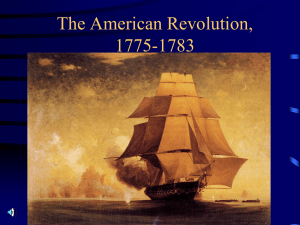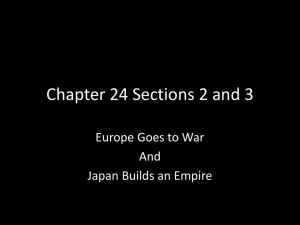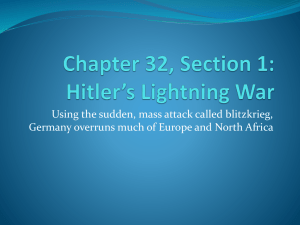How and why has it been interpreted and represented?
advertisement
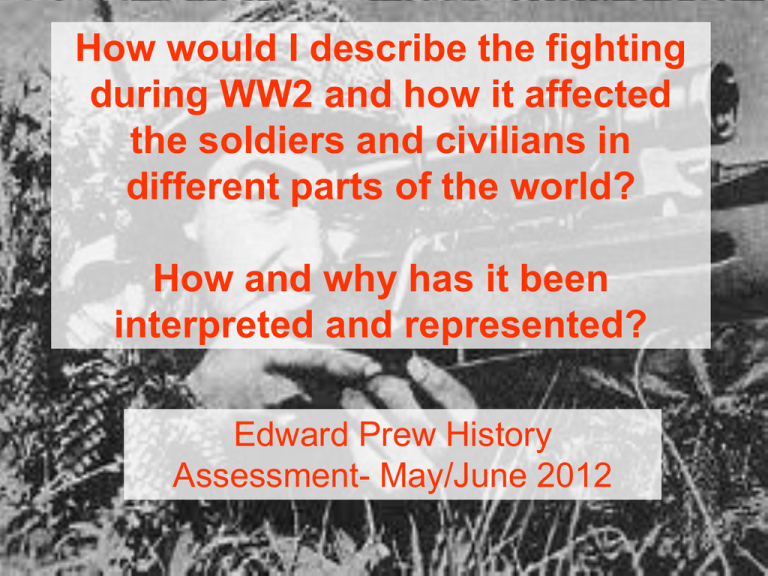
How would I describe the fighting during WW2 and how it affected the soldiers and civilians in different parts of the world? How and why has it been interpreted and represented? Edward Prew History Assessment- May/June 2012 What am I trying to find out? In this Assessment I am going to use several resources as well as my own knowledge to help me find out about a range of aspects in World War Two, what it was like in different places and how destructive it was overall. I will also look at how we look at WW2 in the modern day and how that is different to the late 1940s and the 1950s. I will look at how WW2 veterans and how modern day film makers describe the fighting to give me a broad comparison about the diversity of the most destructive war to date. How destructive was WW2? WW2 was the most widely fought war that there has ever been, many countries were involved in WW2, including most of Europe, Northern Africa, Asia, North America and Australia (as you can see on the map above). This resulted in about 70 million deaths overall, considering that there were less than 1 billion people alive before WW2, this means that about 7.5% of the population died, today that’s an equivalent of 490,000,000! That’s more than all of USA, Canada and Russia’ population combined. Not to mention all the buildings damaged during bombing and military equipment. So obviously it was hugely destructive! Although there were more deaths in action in WW1, this was less destructive because there was a higher population then and also there were very few civilian deaths, which there were in WW2, also in WW1 there was less infrastructure damaged. Why was it so destructive? WW2 was so completely destructive because of the technological advancements and change in political ideology since WW1. One of the greatest advancement in technology which led to massive destruction was the radio. In WW1 there were no portable radios which meant that there could be very limited communication between ground troops, artillery and tanks. In WW2 there were radios which could be carried on soldiers backs, allowing them to tell artillery where to aim and when to fire. This meant shots were deadly accurate and it took only a few shots to perfectly get the correct target leaving little time for people to escape. Another massive technical advancement was the weapons used which were much more deadly and also much more accurate, many new weapons were made including new incendiary bombs, planes (such as the Spitfire) and the nuclear bomb. However new technology also helped to prevent deaths, for example the radar helped to locate enemy fighters and tell people when to go in shelters. Watch the following clip from chapter 2, 3:55- 4:15. The Fallen (2004) As you can see it shows how ground troops were now able to request artillery when they were under a large amount of resistance. Why was WW2 so destructive (continued) Another reason why WW2 was so destructive was because there was a lot of racism and anger, leading to no respect in the way people fought and the way people refused to surrender. The Nazis had very racist ideas, leading to concentration camps for Jews, Slavs and other political parties. And since communism was becoming popular it was easy to see why many countries were scared of one another and therefore became racist. WW2 was also very damaging because of the determination not to lose the war so sometimes suicidal tactics were used (as you can see on the clip to the right). How similar or different was WW2 in different parts of the world? There were 3 main different places were WW2 took place: Western Europe, Eastern Europe and The Pacific,. The fighting styles in each of these places were quite different as you can see in the next few slides… The Far East… Please follow hyperlink… http://ww2history.com/videos/Pacific/Japane se_1942_defeat_of_the_allies As you can see battles in the Far East were fought with a lot of violence and fire was used a lot because the jungle would burn quickly and buildings were made mostly out of wood. Because of the thick jungle there were only animal tracks, it was hot and humid with bogs everywhere and tropical rainstorms. There were animal noises rustling in the trees which could easily be mistaken for the enemy. There were also poisonous snakes in the grassland which injured many soldiers and foxholes which the enemy sometimes hid in. Because of the amount of thick jungle, to kill an enemy you had to get right up to them and kill them in a battle, which was usually very bloody. The Japanese believed in “The Cult of Bushido” which meant that they didn’t respect weakness and therefore didn’t surrender, so they treated the few POWs they kept alive very badly. They would often starve them or work them to death, and if they refused to comply then they would be left to die. Prisoners were crept in extremely cramped bamboo huts which leaked so malaria and mosquitoes flourished and many went blind. There were 60,000 POWs, in which 15,000 died! Also as near the end of the war Allied troops were very tired and wanted the war to end quickly, and because the Americans were still seething from the surprise Pearl Harbor attack, the Geneva Convention was often forgotten with surrenders’ getting murdered. Because of the anger and impatience, in the end an atomic bomb was dropped. An example of the Japanese using suicidal tactics to defeat Allied forces. Day of the Kamikaze In the end to finish the Pacific war the Allies dropped the Atomic Bomb as the following video explains http://ww2history.com/videos/Pacific/The_de cision_to_drop_the_bomb The Eastern Europe What was the fighting like in the Soviet Union? Click here to learn more about the fighting Fighting in the Far East and the Soviet Union were quite different, however they did have a few similarities. For example in both places the environments and weathers were extreme. This gave the people fighting on home turf a massive advantage over their enemies, in the Far East the Allies struggled to fight in the jungle as the Nazis tanks didn’t work in the freezing Russian snow. Although, unlike the Far East, the fighting was fought in wide open grassland meaning that you could spot the enemy from a great distance so there was a massive use for artillery. The attack was so unexpected that people had to be trained in a matter of weeks how to become soldiers: shooting, throwing grenades, street fighting, digging trenches and crawling. It was much more like WW1 in the way they fought. Children were signed up for auxiliary work. There was no respect between the Soviets and Nazis because the Nazis were so determined to abolish communism. The disrespect led to anger, so the Nazis bombed Russia heavily to finish the battle (and then probably war) quickly. The temperature was freezing and people fighting on both sides were dying because of severe hyperthermia, because people would get so hungry they would steal a dead friend ration card for extra food. In great contrast, in summer it could get very hot, like in the Far East! Russian citizens were told to fight if the Nazis invaded their villages. They were called Partisans. When Nazis invaded villages they would sometimes murder, rape and rob towns and then burn them down afterwards. Infact 25,000 citizens were killed in 2 days of the war because of this! Unlike the Far East they wouldn’t take POWs and hung anyone who surrendered and the few prisoners who were taken were abused and often beaten to death, starved, or sent to labor camps. Fighting in Western Europe What happened in Eastern Europe? 1939… Great Britain and France declare war on Germany because of the invasion of Poland, which meant that Hitler was not able to invade Russia. 1940… Hitler took the 1st front of France and troops retreated to Britain during Dunkirk. The Battle of Britain began shortly after this, Hitler intended to finish the battle quickly and continue with his plan of invading Russia. However Britain didn’t give in despite 18 months of bombing, and the advantage began to shift towards the Allies. 1941… Hitler turned back towards the Eastern Front and the Western Front had time to prepare an attack. 1943… Britain bombs Germany more heavily reducing the Luftwaffe and the German defence. 1944… D-Day- After months and years of fighting and preparations, the western allies were finally ready for their decisive move of invading Western Europe in order to occupy Germany from West to match the Russian advance from the East. D-Day, the invasion of France, did not change the outcome of the war, as Germany was already losing it, but it marked the long awaited beginning of the last chapter of the war. The war ended a year after D-Day . What was bombing like? I am now going to compare the bombing in different places in the world. Bombing accounted for most of the deaths during WW2 so obviously it was hugely important! I will compare the bombing in Great Britain, Germany, Japan and Russia. Bombing in Britain In Great Britain innocent civilians were involved, however they and the Government tried to keep moral up by putting up posters saying “Britain can take it!" or “Keep calm and carry on!” Citizens knew that Britain would fight back soon and make the Nazis pay for all their bombing and that they were holding up Hitler's war effort, because of this unbeatens some people took shelter under churches because they thought that God would protect them. Infact because of the happiness the Germans thought that the bombing campaign wasn’t working! However, despite desperately trying to be happy it was hard to ignore the fact that they were bombed 57 days in a row and 60,000 people were killed (40,000 of which were in London), in the capital 30,000 tones of bombs were dropped. If a bomb was dropped near you then you could be thrown back because of the impact. Because of incendiary bombs there were fires leading to the stench of burning flesh or limbs which had been separated from the body! The Nazis aimed bombs at the UKs historic places such as Westminster Abbey, St. Paul's Cathedral or Buckingham Palace. Eventually anger grew in London which was at Hitler, but also at the Prime Minister because he wasn’t doing everything he said he’d do, also there was much bitterness, especially in the East end. Bombing in Germany Although 60,000 people died in Great Britain, the casualties were much greater in Germany. One night in Hamburg more bombs were dropped then in 11 months of the London Blitz and 5000 bombs were dropped in 3 days! This resulted in 50,000 civilian deaths. Hundreds of planes would fly above Germany in formation during day and night, and machine guns would be constantly firing at them, this sound turned some people insane because of the fear they were going to die. In Dresden there was fire bombing which meant that massive infernos of fire consumed cities, infrastructure and people with temperatures reaching 1000°C. Like the Germans, Britain aimed to take German morale so that citizens would turn against the Nazis. This worked as many Germans persevered the Nazis to be ‘murdering’ them and their families. Infact some Nazi officials were attacked on the streets! Bombing in Russia Hitler bombed Russia very heavily because he wanted to defeat them in a surprise attack. The Nazis dropped 1000 tones of bombs in 1 night. Fire bombing was used leading to infernos of fire that could be seen 3500m into the sky! This lead to thousands of deaths and lots of rubble and shrapnel in the cities. Bombing in Japan Japan was arguably the worst bombed country of all because raids were unexpected and happened in a matter of seconds, once again fire bombing was used, but in Japan the destruction was amplified because building were made of wood which burned easily. People burned to death or suffocated to death with ash rain coming down after bomb raids. 600,000 people died because of fire bombing 100,000 were killed in March 1945, which was more than the nuclear bombs put together! 60 Japanese cities were bombed and 64% of all bombs dropped were incendiaries. In Tokyo there were 65 raids resulting in 137,582 deaths, infact on the 9th-10th March 1945 an estimated 20% of Tokyo's war industries and 60% of businesses were destroyed. In the end 10 million people moved away from cities! Why has WW2 been seen in different ways at different times? Click on several of the film clips below… WW2 Films… During WW2 During the Cold war After the Cold War DDay - The Sixth of June (1956) Guadalcanal Diary (1943) Bataan (1943) Objective Burma (1945) The Longest Day (1962) Cross of Iron (1976) Saving Private Ryan (1998) The Fallen (2004) Days of Glory (2006) What do the films tell us about peoples’ presentation of the war? In the pre 1950 films whilst the war was still being fought, the films implied that the Allies were winning the war very quickly with very few casualties. They also made out that the enemies were cowards and that the Allies weren’t doing anything wrong. It also didn’t show any blood. This was probably to put families back home at ease that troops were quite safe, and that if they did die then they would die painlessly and with pride. In the films made in the time of the Cold War it shows a lot of enemy deaths, which are made to look quite easy. Whereas when an Allied soldier dies he is made to look like a hero who has served his country (like at the end of the DDay- the 6th of June clip). This was probably done to encourage people to join the army because of the threat of a war with Russia. They wanted to show that if you fought then you were a hero. After the Cold War when they did not need people to join the army so much, films became more realistic with less propaganda. Blood was shown and films were much more gory. It showed what truly happened in the war with people from both sides dying and committing war crimes. This was probably done to show the horrors of war, and educate young people about why wars can’t be used to solve future struggles. What do modern film makers think about WW2 compared to WW2 veterans? What was the overall impact of WW2? From the years 1939- 1945 everyone was part of the war. Even if countries weren’t officially in the war (like Switzerland) they were still greatly affected. The fighting in WW2 was completely different to fighting of any other style because of the huge technological advances and the change in tactics which had been used in WW1 and were invented by the Ancient Greeks. It was the first time a battle had been fought in many places at once with so many new political, social and economic ideas trying to take over the world. The Geneva Convention was often forgotten about as hundreds of war crimes were committed, and, unlike WW1 civilians were hugely affected and were killed more frequently then soldiers were. It has also been documented in many different styles which affected that era, whether it was sending out messages for people to recruit in the Cold War, or to try and get peace in the modern day.
